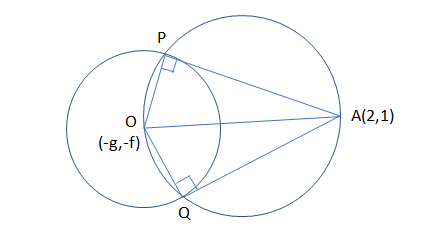
A point A(2, 1) is outside the circle ${{x}^{2}}+{{y}^{2}}+2gx+2fy+c=0$ and AP, AQ are the tangents to the circle. The equation of the circle circumscribing the triangle APQ is:
(a) (x+g)(x-2)+(y+f)(y-1)=0
(b) (x+g)(x-2)-(y+f)(y-1)=0
(c) (x-g)(x+2)+(y-f)(y+1)=0
(d) (x-g)(x-2)+(y-f)(y-1)=0
Answer
571.2k+ views
Hint: First, before proceeding for this, we must draw the following circle with all the conditions mentioned in the question to understand it easily. Then, from the figure, we can see clearly that we need to find the equation of the new circle formed whose diameter is OA. Then, by finding the slope of the two lines AO and OP, and by using the condition that two perpendicular lines slope when multiplied gives the value as -1, we get the final expression of the required circle.
Complete step by step answer:
In this question, we are supposed to find the equation of the circle circumscribing the triangle APQ when a point A(2, 1) is outside the circle ${{x}^{2}}+{{y}^{2}}+2gx+2fy+c=0$ and AP, AQ are the tangents to the circle.
So, before proceeding for this, we must draw the following circle with all the conditions mentioned in the question to understand it easily as:

Now, let us assume the coordinates of P as (h, k) and then proceed further.
Then, from the figure, we can see clearly that we need to find the equation of the new circle formed whose diameter is OA.
So, by using the slope ${{m}_{1}}$ of the line AP, we get:
${{m}_{1}}=\dfrac{k-1}{h-2}$
Similarly, we can find the slope ${{m}_{2}}$of the line OP, we get:
${{m}_{2}}=\dfrac{k+f}{h+g}$
Now, we know that two perpendicular lines slope when multiplied gives the value as -1.
So, we can see that lines AP and OP are perpendicular and by applying the same condition on them, we get:
${{m}_{1}}\times {{m}_{2}}=-1$
Now, by substituting the value of ${{m}_{1}}$and ${{m}_{2}}$ in the above expression, we get:
$\dfrac{k-1}{h-2}\times \dfrac{k+f}{h+g}=-1$
Then, by solving the above expression, we get:
$\begin{align}
& \left( k-1 \right)\left( k+f \right)=-\left( h-2 \right)\left( h+g \right) \\
& \Rightarrow \left( k-1 \right)\left( k+f \right)+\left( h-2 \right)\left( h+g \right)=0 \\
\end{align}$
Now, to get the expression of the circle in coordinates form, we replace h by x and k by y, then we get:
$\left( y-1 \right)\left( y+f \right)+\left( x-2 \right)\left( x+g \right)=0$
So, we get the equation of the circle as $\left( x-2 \right)\left( x+g \right)+\left( y-1 \right)\left( y+f \right)=0$.
So, the correct answer is “Option A”.
Note: Now, to solve these types of questions we need to know some of the basics of the straight line equation beforehand to solve accurately. So, the equation of the straight line with slope m and points $\left( {{x}_{1}},{{y}_{1}} \right) $is given by:
$y-{{y}_{1}}=m\left( x-{{x}_{1}} \right)$
Complete step by step answer:
In this question, we are supposed to find the equation of the circle circumscribing the triangle APQ when a point A(2, 1) is outside the circle ${{x}^{2}}+{{y}^{2}}+2gx+2fy+c=0$ and AP, AQ are the tangents to the circle.
So, before proceeding for this, we must draw the following circle with all the conditions mentioned in the question to understand it easily as:

Now, let us assume the coordinates of P as (h, k) and then proceed further.
Then, from the figure, we can see clearly that we need to find the equation of the new circle formed whose diameter is OA.
So, by using the slope ${{m}_{1}}$ of the line AP, we get:
${{m}_{1}}=\dfrac{k-1}{h-2}$
Similarly, we can find the slope ${{m}_{2}}$of the line OP, we get:
${{m}_{2}}=\dfrac{k+f}{h+g}$
Now, we know that two perpendicular lines slope when multiplied gives the value as -1.
So, we can see that lines AP and OP are perpendicular and by applying the same condition on them, we get:
${{m}_{1}}\times {{m}_{2}}=-1$
Now, by substituting the value of ${{m}_{1}}$and ${{m}_{2}}$ in the above expression, we get:
$\dfrac{k-1}{h-2}\times \dfrac{k+f}{h+g}=-1$
Then, by solving the above expression, we get:
$\begin{align}
& \left( k-1 \right)\left( k+f \right)=-\left( h-2 \right)\left( h+g \right) \\
& \Rightarrow \left( k-1 \right)\left( k+f \right)+\left( h-2 \right)\left( h+g \right)=0 \\
\end{align}$
Now, to get the expression of the circle in coordinates form, we replace h by x and k by y, then we get:
$\left( y-1 \right)\left( y+f \right)+\left( x-2 \right)\left( x+g \right)=0$
So, we get the equation of the circle as $\left( x-2 \right)\left( x+g \right)+\left( y-1 \right)\left( y+f \right)=0$.
So, the correct answer is “Option A”.
Note: Now, to solve these types of questions we need to know some of the basics of the straight line equation beforehand to solve accurately. So, the equation of the straight line with slope m and points $\left( {{x}_{1}},{{y}_{1}} \right) $is given by:
$y-{{y}_{1}}=m\left( x-{{x}_{1}} \right)$
Recently Updated Pages
Why are manures considered better than fertilizers class 11 biology CBSE

Find the coordinates of the midpoint of the line segment class 11 maths CBSE

Distinguish between static friction limiting friction class 11 physics CBSE

The Chairman of the constituent Assembly was A Jawaharlal class 11 social science CBSE

The first National Commission on Labour NCL submitted class 11 social science CBSE

Number of all subshell of n + l 7 is A 4 B 5 C 6 D class 11 chemistry CBSE

Trending doubts
What is meant by exothermic and endothermic reactions class 11 chemistry CBSE

10 examples of friction in our daily life

One Metric ton is equal to kg A 10000 B 1000 C 100 class 11 physics CBSE

1 Quintal is equal to a 110 kg b 10 kg c 100kg d 1000 class 11 physics CBSE

Difference Between Prokaryotic Cells and Eukaryotic Cells

What are Quantum numbers Explain the quantum number class 11 chemistry CBSE




